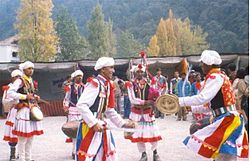- Chholiya
-
Chholiya (Kumaoni-छोलिया) is a dance form practised in the Kumaun region of Uttarakhand. It is basically a sword dance accompanying a marriage procession but now it is performed on many auspicious occasions.[1]
It is especially popular in the districts of Pithoragarh, Champawat, Bageshwar and Almora of Kumaon division and has even spread to the Garhwal division.
This sword dance has a history of more than a thousand years and is rooted in the martial traditions of the Kumauni people.
Contents
Origin
Dating back to over a thousand years, the Chholiya Dance has its origins in the warring Kshatriyas of Kumaun- the Khasas, when marriages were performed at the point of the swords.
The native Kshatriyas were united by the Chand Kings who arrived' on the scene in the 10th century. Flux of immigrants Rajputs who made native kshatriyas a small minority also took on the hill customs and influenced pahari culture with their traditions & language.The days of marriages on the point of sword were over but the traditions attached to it still continued.
That is why the groom is still known as Kunwar (कुंवर) or Raja (राजा) (King) in Kumaun. He rides a horse in the marriage procession and wears a Khukri in his belt.[2]
Significance
Apart from its origins in the martial traditions of the people of Kumaun, it is also has religious significance.
Chholiya is performed in marriages and is believed to be auspicious as it provides protection from evil spirits and demons. Marriage processions were believed to be vulnerable to such spirits who target peoples happiness. It was a common belief that demons followed a marriage procession or Baryat(बर्यात) to bewitch the newly married and performance of Chholiya could prevent this.
Instruments
The turi (तुरी), nagphani (नागफनी) and ransing (रणसिंघ) belonging to the brass instrument family are traditional instruments of the Kumaon division, were earlier used in battles to increase the morale of the troops, are used.
Percussion instruments like dhol (ढोल), damau (दमाऊ) which are also native to Kumaun are played by professional musicians known as dholies.
Masakbeen(मसकबीन) or Bagpipe introduced by the British in Kumaun as instruments played in marching bands were assimilated into the wide range of instruments played.
Woodwind instruments like the nausuriya muruli (नौसुरिया मुरूली) (lit. the nine note flute) akind of flute and jyonya (ज्योंया) (lit. twin flute) a type of double flute native to Kumaun is also played.[3]
Attire
Donning the traditional Kumauni attire white churidar payajama, the taanka on their heads, the chola, face covered with sandal wood paste as if ready for battle equipped with tulwar swords and brass shields. Their costume resembles the costume of the ancient martial warriors that inhabited Kumaun. [4]
Features
Accompanied by war-like music, equipped with swords they dance in a perfectly synchronised manner while engaging in mock fights with their fellow dancers.
Carrying the triangular red flag the nisaan (निसाण), (banners), waving their swords, with fiery expressions on the faces they give the impression of warriors going to battle.
There are 22 men in a full team of Chholiya dancers 8 of them are the sword dancers and the rest 14 are musicians.
Forms
The following are the forms of Chholiya popular all over Kumaun which differ in movements
- Bisu nritya (बिसू नृत्य )
- Saraanv (mock fights) (सरांव)
- Rann nritya (lit. war dance) (रण नृत्य)
- Sarankar (सरंकार)
- Veerangana (वीरांगना)
- Chholiya Baja (छोलिया बाजा)
- Shauka Shaili (शौका शैली) native to Johar region of Kumaun
- Paitan Baja (पैटण बाजा)
References
- ^ "Folk Dances Of North India". Culturalindia.net. http://www.culturalindia.net/indian-dance/folk-dances/north-india.html. Retrieved 2010-06-12.
- ^ "Choliya Dance - Folk Dances of Kumaon". Euttaranchal.com. http://www.euttaranchal.com/uttaranchal/music_cinema/choliya_dance.php. Retrieved 2010-06-12.
- ^ "Welcome to Chhaliya Mahotsava, Pithoragarh". Chhaliyamahotsava.com. http://chhaliyamahotsava.com/home.htm. Retrieved 2010-06-12.
- ^ "Choliya Dance - Choliya Dance Uttarakhand, Cholia Dance Uttaranchal". Himalaya2000.com. http://www.himalaya2000.com/uttarakhand/dances/choliya.html. Retrieved 2010-06-12.
- The Himalayan Gazetter by E. T. Atkinson
- The History of Kumaun by B. D. Pandey
See also
- Kumaon
- Kumaoni people
- Uttarakhand
- Sword dance
Categories:- Kumaon
- Uttarakhand
- Culture of Uttarakhand
- Dances of India
Wikimedia Foundation. 2010.


